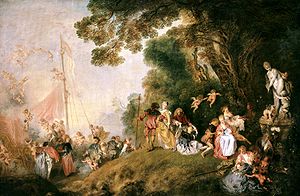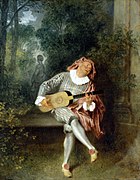This articleneeds additional citations forverification.(March 2013) |
Fête galante(French pronunciation:[fɛːtɡalɑ̃t]) (courtship party) is a category of painting specially created by theFrench Academyin 1717 to describeAntoine Watteau's(1684–1721) variations on the theme of thefête champêtre,which featured figures in ball dress or masquerade costumes disporting themselves amorously in parkland settings. When Watteau applied to join the French academy in 1717, there was no suitable category for his works, so the academy simply created one rather than reject his application. Hisreception piecewas theEmbarkation for Cythera,now in theLouvre.[1][2][3]

Watteau wanted recognition from the government-appointedAcademy of Painting and Sculpture.The Academy upheld thehierarchy of genres,ranking scenes of everyday life and portraits, the paintings most desired by private patrons, as lower than morally educational paintings illustratinghistory paintings,includingallegoriesand scenes frommythology.
-
Mezzetin,1718/9
Wider context
editFête galantepaintings are an important part of theRococoperiod of art, which saw the focus of European arts move away from the hierarchical, standardized grandeur of the church androyal courtand toward an appreciation for intimacy and personal pleasures. Nonetheless, the lush, outdoor settings offête galantepaintings were often borrowed from earlier paintings, especially from Venetian paintings of the 16th century and Dutch paintings of the 17th century.
The nineteenth century saw an anachronistic revival of such scenes in thecostume genredepictions orscene galantepaintings by, for example,Arturo Ricci.
-
Nicolas Lancret,circa 1730
-
Jean François de Troy,The Declaration of Love, 1731.
Examples
edit- L'Accord Parfait(LACMA)- painted by Watteau between 1717 and 1718. A lovely young woman holds music for a homely old man playing aflute.
- Le Collation- by Pater. Gentry flirt and pick flowers before a female nude reclining on a mound shaped like a sea shell. The nude probably represents the goddessVenus.
- Danse dans le Parc- byNicolas Lancret.Lavishly dressed courtiers dance before the statue of an heroic male nude. Male nudes were a favorite subject of history paintings, so this statue clearly is meant to elevate the dancers to "historical" status.
- Declaration of Love- painted byJean François de Troyin 1731. De Troy's style is much more realistic than most. This painting was purchased byFrederick II of Prussiaand hung in theSans Soucipalace.
- Les Deux Cousines- painted by Watteau between 1717 and 1718. Two women in whitesatingowns are offered a red cape by a gallant young man. As in other fête galante paintings, Greco-Roman statues along the lake help elevate this genre scene tohistory paintingstatus.
- Gardens of the Villa d'Este at Tivoli- painted by Fragonard.Classical architectureprovides the backdrop for an outdoor meal and games.
- A Lady in a Garden Taking Coffee With Some Children- painted by Lancret about 1742. A woman seated next to a fountain in a lavish garden spoons some exotic coffee over to her children while two men- probably a husband and a servant- look on.
- Mezzetino- painted by Watteau between 1718 and 1720. Not technically a fête galante, this painting shows a pathetic figure from the Italiancommedia dell'arteserenading a statue.
- APilgrimage to Cythera- painted by Watteau in 1717. Beautifully dressed aristocrats, attended by cherubs, visit an island supposedly dedicated to the ancient love goddessCythera.This painting is often held up as the prototype of the fête galante.
- The Shepherds- painted by Watteau about 1716. This painting plays on a long tradition of aristocrats pretending to be rural shepherds, a tradition which flourished in the 18th century, most famously at the mock hamlet ofMarie Antoinette.
- Venetian Pleasures- painted by Watteau between 1718 and 1719. Two dancers (the man in Arabian costume) perform for a crowd of onlookers in front of a statue of Venus. The bagpiper may be aself-portrait.
References
edit- ^Kleiner, Fred, S. (Ed.) (2011)Gardner's Art Through the Ages: A global history.Enhanced 13th edn. Boston: Wadsworth, p. 755.ISBN978-0-495-79986-3
- ^Clarke, M. & D. (2010) "fête galante" inThe Concise Oxford Dictionary of Art Terms.oxfordreference.com,Oxford University Press.Retrieved 8 November 2013.
- ^Fête GalanteArchived2016-11-16 at theWayback MachineGlossary,National Gallery,2013. Retrieved 8 November 2013.

